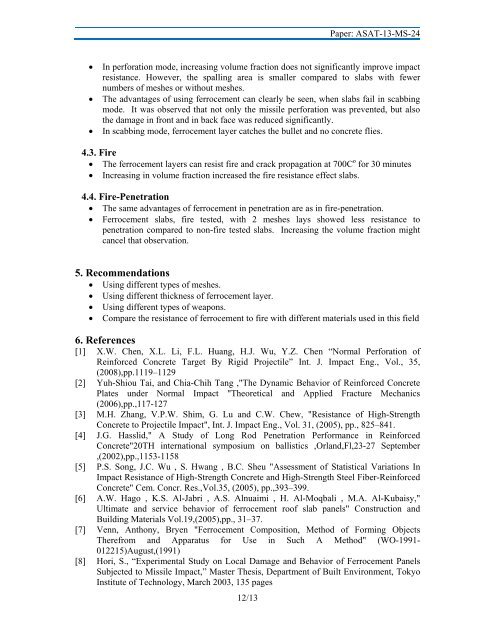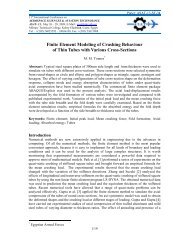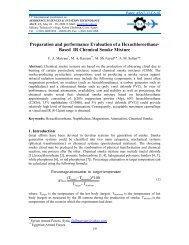Effect of Using Ferro-Cement on the Mechanical Properties of ...
Effect of Using Ferro-Cement on the Mechanical Properties of ...
Effect of Using Ferro-Cement on the Mechanical Properties of ...
Create successful ePaper yourself
Turn your PDF publications into a flip-book with our unique Google optimized e-Paper software.
12/13<br />
Paper: ASAT-13-MS-24<br />
� In perforati<strong>on</strong> mode, increasing volume fracti<strong>on</strong> does not significantly improve impact<br />
resistance. However, <strong>the</strong> spalling area is smaller compared to slabs with fewer<br />
numbers <str<strong>on</strong>g>of</str<strong>on</strong>g> meshes or without meshes.<br />
� The advantages <str<strong>on</strong>g>of</str<strong>on</strong>g> using ferrocement can clearly be seen, when slabs fail in scabbing<br />
mode. It was observed that not <strong>on</strong>ly <strong>the</strong> missile perforati<strong>on</strong> was prevented, but also<br />
<strong>the</strong> damage in fr<strong>on</strong>t and in back face was reduced significantly.<br />
� In scabbing mode, ferrocement layer catches <strong>the</strong> bullet and no c<strong>on</strong>crete flies.<br />
4.3. Fire<br />
� The ferrocement layers can resist fire and crack propagati<strong>on</strong> at 700C o for 30 minutes<br />
� Increasing in volume fracti<strong>on</strong> increased <strong>the</strong> fire resistance effect slabs.<br />
4.4. Fire-Penetrati<strong>on</strong><br />
� The same advantages <str<strong>on</strong>g>of</str<strong>on</strong>g> ferrocement in penetrati<strong>on</strong> are as in fire-penetrati<strong>on</strong>.<br />
� <str<strong>on</strong>g>Ferro</str<strong>on</strong>g>cement slabs, fire tested, with 2 meshes lays showed less resistance to<br />
penetrati<strong>on</strong> compared to n<strong>on</strong>-fire tested slabs. Increasing <strong>the</strong> volume fracti<strong>on</strong> might<br />
cancel that observati<strong>on</strong>.<br />
5. Recommendati<strong>on</strong>s<br />
� <str<strong>on</strong>g>Using</str<strong>on</strong>g> different types <str<strong>on</strong>g>of</str<strong>on</strong>g> meshes.<br />
� <str<strong>on</strong>g>Using</str<strong>on</strong>g> different thickness <str<strong>on</strong>g>of</str<strong>on</strong>g> ferrocement layer.<br />
� <str<strong>on</strong>g>Using</str<strong>on</strong>g> different types <str<strong>on</strong>g>of</str<strong>on</strong>g> weap<strong>on</strong>s.<br />
� Compare <strong>the</strong> resistance <str<strong>on</strong>g>of</str<strong>on</strong>g> ferrocement to fire with different materials used in this field<br />
6. References<br />
[1] X.W. Chen, X.L. Li, F.L. Huang, H.J. Wu, Y.Z. Chen “Normal Perforati<strong>on</strong> <str<strong>on</strong>g>of</str<strong>on</strong>g><br />
Reinforced C<strong>on</strong>crete Target By Rigid Projectile” Int. J. Impact Eng., Vol., 35,<br />
(2008),pp.1119–1129<br />
[2] Yuh-Shiou Tai, and Chia-Chih Tang ,"The Dynamic Behavior <str<strong>on</strong>g>of</str<strong>on</strong>g> Reinforced C<strong>on</strong>crete<br />
Plates under Normal Impact "Theoretical and Applied Fracture Mechanics<br />
(2006),pp.,117-127<br />
[3] M.H. Zhang, V.P.W. Shim, G. Lu and C.W. Chew, "Resistance <str<strong>on</strong>g>of</str<strong>on</strong>g> High-Strength<br />
C<strong>on</strong>crete to Projectile Impact", Int. J. Impact Eng., Vol. 31, (2005), pp., 825–841.<br />
[4] J.G. Hasslid," A Study <str<strong>on</strong>g>of</str<strong>on</strong>g> L<strong>on</strong>g Rod Penetrati<strong>on</strong> Performance in Reinforced<br />
C<strong>on</strong>crete"20TH internati<strong>on</strong>al symposium <strong>on</strong> ballistics ,Orland,Fl,23-27 September<br />
,(2002),pp.,1153-1158<br />
[5] P.S. S<strong>on</strong>g, J.C. Wu , S. Hwang , B.C. Sheu "Assessment <str<strong>on</strong>g>of</str<strong>on</strong>g> Statistical Variati<strong>on</strong>s In<br />
Impact Resistance <str<strong>on</strong>g>of</str<strong>on</strong>g> High-Strength C<strong>on</strong>crete and High-Strength Steel Fiber-Reinforced<br />
C<strong>on</strong>crete" Cem. C<strong>on</strong>cr. Res.,Vol.35, (2005), pp.,393–399.<br />
[6] A.W. Hago , K.S. Al-Jabri , A.S. Alnuaimi , H. Al-Moqbali , M.A. Al-Kubaisy,"<br />
Ultimate and service behavior <str<strong>on</strong>g>of</str<strong>on</strong>g> ferrocement ro<str<strong>on</strong>g>of</str<strong>on</strong>g> slab panels" C<strong>on</strong>structi<strong>on</strong> and<br />
Building Materials Vol.19,(2005),pp., 31–37.<br />
[7] Venn, Anth<strong>on</strong>y, Bryen "<str<strong>on</strong>g>Ferro</str<strong>on</strong>g>cement Compositi<strong>on</strong>, Method <str<strong>on</strong>g>of</str<strong>on</strong>g> Forming Objects<br />
Therefrom and Apparatus for Use in Such A Method" (WO-1991-<br />
012215)August,(1991)<br />
[8] Hori, S., “Experimental Study <strong>on</strong> Local Damage and Behavior <str<strong>on</strong>g>of</str<strong>on</strong>g> <str<strong>on</strong>g>Ferro</str<strong>on</strong>g>cement Panels<br />
Subjected to Missile Impact,” Master Thesis, Department <str<strong>on</strong>g>of</str<strong>on</strong>g> Built Envir<strong>on</strong>ment, Tokyo<br />
Institute <str<strong>on</strong>g>of</str<strong>on</strong>g> Technology, March 2003, 135 pages





